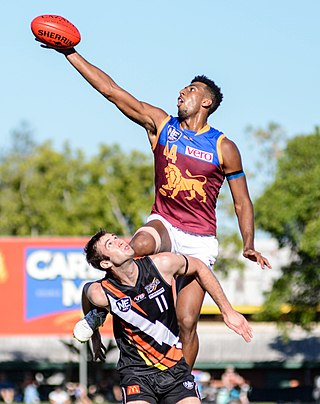
Australian rules football, also called Australian football or Aussie rules, or more simply football or footy, is a contact sport played between two teams of 18 players on an oval field, often a modified cricket ground. Points are scored by kicking the oval ball between the central goal posts, or between a central and outer post.

Gaelic football, commonly known as simply Gaelic, GAA, or football, is an Irish team sport. A form of football, it is played between two teams of 15 players on a rectangular grass pitch. The objective of the sport is to score by kicking or punching the ball into the other team's goal or between two upright posts above the goal and over a crossbar 2.5 metres above the ground.

In sport, a goal may refer to either an instance of scoring, or to the physical structure or area where an attacking team must send the ball or puck in order to score points. The structure of a goal varies from sport to sport, and one is placed at or near each end of the playing field for each team to defend. Sports which feature goal scoring are also commonly known as invasion games.
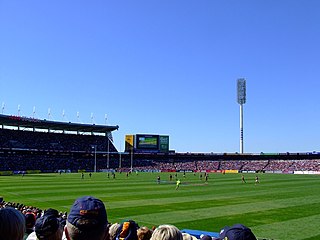
Football Park, known commercially as AAMI Stadium, was an Australian rules football stadium located in West Lakes, a western suburb of Adelaide, the state capital of South Australia, Australia. It was built in 1973 by the South Australian National Football League (SANFL) and opened in 1974. Until the end of the 2013 AFL season, it served as the home ground of South Australia's AFL clubs, the Adelaide Football Club and Port Adelaide Football Club. It also hosted all SANFL finals from 1974 to 2013. Demolition of the stadium's grandstands began in August 2018, and finished in March 2019.

International rules football is a team sport consisting of a hybrid of football codes, which was developed to facilitate international representative matches between Australian rules football players and Gaelic football players.

A football pitch or soccer field is the playing surface for the game of association football. Its dimensions and markings are defined by Law 1 of the Laws of the Game, "The Field of Play". The pitch is typically made of natural turf or artificial turf, although amateur and recreational teams often play on dirt fields. Artificial surfaces are allowed only to be green in colour.

A throw-in is a method of restarting play in a game of association football when the whole of ball passes over the touchline. It is governed by Law 15 of the Laws of the Game. In Scotland it is known as a shy.

The laws of Australian rules football were first defined by the Melbourne Football Club in 1859 and have been amended over the years as Australian rules football evolved into its modern form. The Australian Football Council (AFC), was formed in 1905 and became responsible for the laws, although individual leagues retained a wide discretion to vary them. Following the restructure of the Victorian Football League's competition as a national competition and the League's renaming to be the Australian Football League (AFL), since 1994, the rules for the game have been maintained by the AFL through its Commission and its Competition Committee.

A cricket field or cricket oval is a large grass field on which the game of cricket is played. Although generally oval in shape, there is a wide variety within this: perfect circles, elongated ovals, rounded rectangles, or irregular shapes with little or no symmetry – but they will have smooth boundaries without sharp corners, almost without exception. There are no fixed dimensions for the field but its diameter usually varies between 450 and 500 feet for men's cricket, and between 360 feet (110 m) and 420 feet (130 m) for women's cricket.

A comparison of American football and rugby union is possible because of the games' shared origins, despite their dissimilarities.
A comparison between American football and rugby league is possible because of their shared origins and similar game concepts. Rugby league is arguably the most similar sport to American football after Canadian football: both sports involve the concept of a limited number of downs/tackles and scoring touchdowns/tries takes clear precedence over goal-kicking.
Australian rules football was first organised in Victoria in 1859 when its rules were codified by the Melbourne Football Club.
Variations of Australian rules football are games or activities based on or similar to the game of Australian rules football, in which the player uses common Australian rules football skills. They range in player numbers from 2 up to the minimum 38 required for a full Australian rules football.

This list is an alphabetical glossary of Australian rules football terms, jargon and slang. While some of these entries are shared with other sports, Australian rules football has developed a unique and rich terminology.
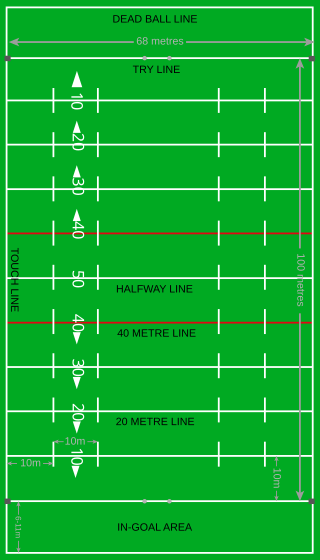
The rugby league playing field, also referred to as a pitch or paddock, is the playing surface for the sport of rugby league football and is surfaced exclusively with grass.
A comparison of Canadian football and rugby union is possible because of the games' shared origins, despite their dissimilarities.
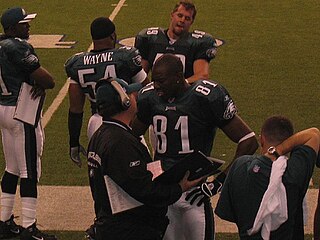
In sports, out of bounds refers to being outside the playing boundaries of the field. The legality of going out of bounds, and the ease of prevention, vary by sport. Sports that use this term include American football, Canadian football, field lacrosse, basketball, rugby union, rugby league, and association football.

Comparison of association football (football/soccer) and rugby union is possible because of the games' similarities and shared origins.
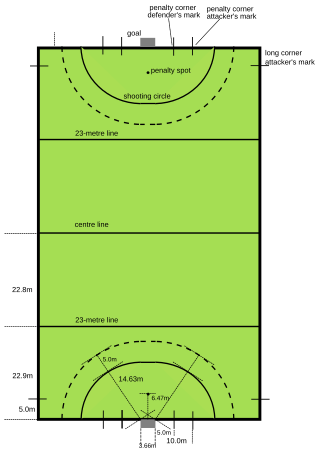
A hockey pitch is the playing surface for the game of field hockey. Historically, the game was played on natural turf (grass) and nowadays it is predominantly played on an artificial turf. The transition to artificial pitches came during the 1970s and was made mandatory for major competitions in 1976. All the lines, markings and goal specifications are outlined by the International Hockey Federation in "The Rules of Hockey".
AFLX is a variation of Australian rules football designed in 2017 to be played on a soccer field. Unlike the full 18-a-side game, AFLX required fewer players with some modified rules aimed at generating higher scores, including increased scoring points. It was founded in an attempt to appeal to a wider audience outside of its origin country of Australia. The AFL billed AFLX as its answer to Twenty20 or Rugby Sevens.

















